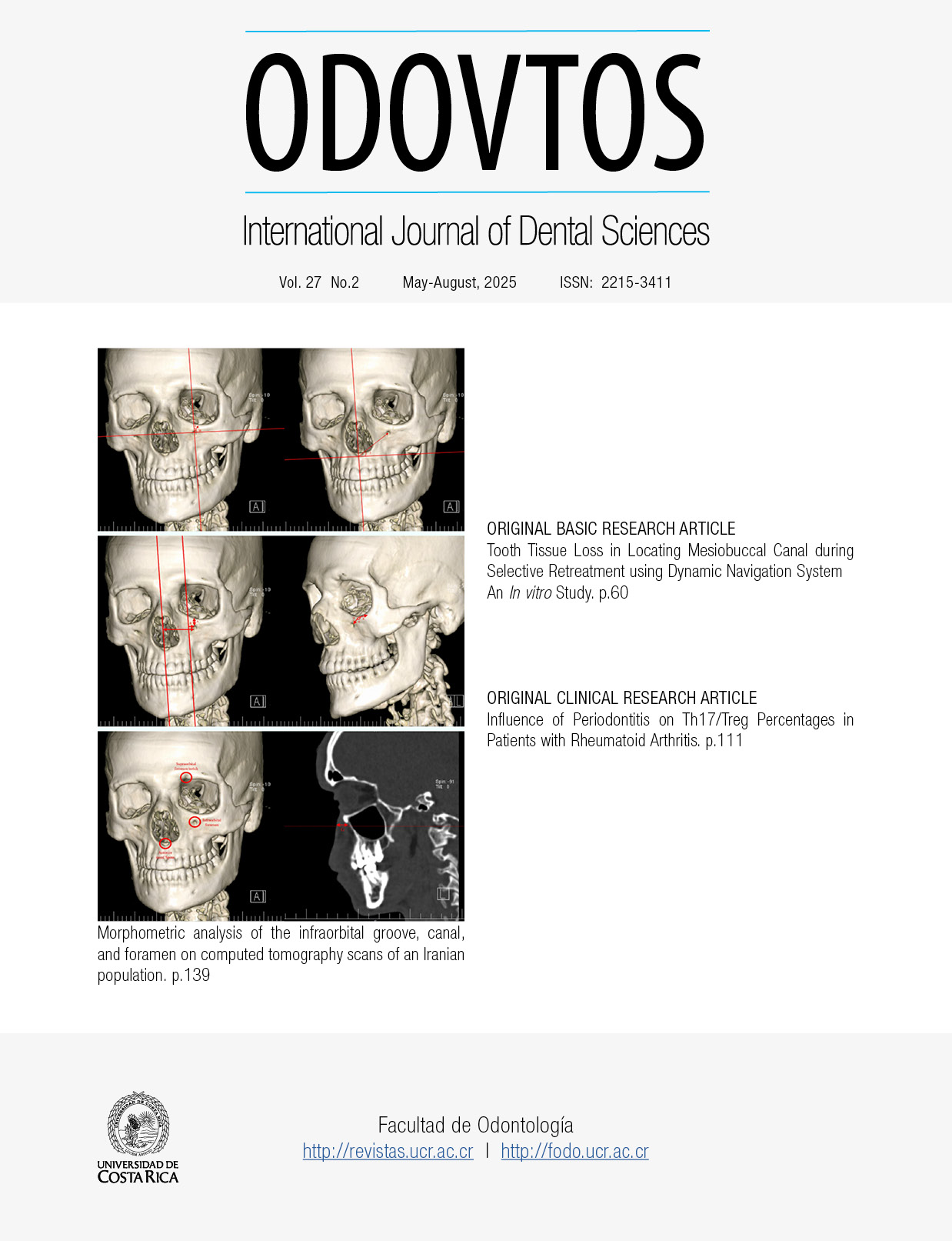Resumen
El retratamiento selectivo del conducto radicular ha demostrado ser exitoso, pero el proceso es un desafío porque la imprecisión compromete la estructura del diente. Así, este estudio in vitro fue diseñado para evaluar de forma comparativa la pérdida de tejido dental y el tiempo necesario para localizar el canal mesiobucal (MB) usando el sistema de navegación dinámica (DNS; Navident, ClaroNav, Toronto , ON, Canadá ) con el método a mano alzada (FH). La hipótesis nula fue que ambos métodos tendrían una pérdida de tejido dental y un tiempo similares. Se utilizaron veinte molares mandibulares humanos tratados con conducto radicular en un maniquí Navident. Utilizando el programa Navident, la ruta de perforación y la profundidad se diseñó virtualmente mediante exploraciones por tomografía computarizada de haz cónico (CBCT). Se preparó una cavidad de mínimo acceso para localizar la raíz del MB con navegación dinámica en el grupo DNS y con mano alzada en el grupo FH. La pérdida volumétrica de tejido dental se evaluó con la ayuda de CBCT postoperatoria y software. El análisis estadístico se realizó con una prueba T para muestras independientes (p<0,05). El tiempo empleado en el procedimiento se registró con un cronómetro. La pérdida de tejido dental fue significativamente menor con el grupo DNS (35,83 mm3) en comparación con el grupo FH (52,84 mm3) con un valor de P de 0,001. El tiempo necesario para el grupo DNS fue menor con el grupo DNS (29,00 segundos) en comparación con el grupo FH (53,60 segundos) con significación estadística con un valor de P de 0,001. La DNS resultó en una pérdida mínima de tejido dental con un tiempo más corto en comparación con el grupo FH. Esta técnica se puede practicar para un retratamiento selectivo predecible en endodoncia.
Citas
Brochado Martins, J.F., Guerreiro Viegas, O., Cristescu, R., Diogo, P. & Shemesh, H. Outcome of selective root canal retreatment-A retrospective study. International Endodontic Journal, 2023; 56: 345-355. Available from: https://doi.org/10.1111/iej.13871
Kirkevang, L.L., Vaeth, M. & Wenzel, A. Ten-year follow-up of root filled teeth: a radiographic study of a Danish population. International Endodontic Journal, 2014; 47: 980-988.
Meirinhos, J., Martins, J.N.R., Pereira, B., Baruwa, A., Gouveia, J., Quaresma, S.A. et al. Prevalence of apical periodontitis and its association with previous root canal treatment, root canal filling length and type of coronal restoration-a cross-sectional study. International Endodontic Journal, 2020: 53; 573-584.
Hoen, M.M. & Pink, F.E. Contemporary endodontic retreat- ments: an analysis based on clinical treatment findings. Journal of Endodontia, 2002: 28; 834-836.
Nudera, W.J. Selective root retreatment: a novel approach. Journal of Endodontia, 2015: 41; 1382-1388.
Jain S.D., Carrico C.K., Bermanis I. 3-Dimensional Accuracy of Dynamic Navigation Technology in Locating Calcified Canals. J Endod. 2020: 46; 839-845. doi: 10.1016/j.joen.2020.03.014. Epub 2020 Apr 25. PMID: 32340763.
Bardales-Alcocer J., Ramírez-Salomón M., Vega-Lizama E., López-Villanueva M., Alvarado-Cárdenas G., Serota K.S., Ramírez-Wong J. Endodontic Retreatment Using Dynamic Navigation: A Case Report. J Endod. 2021:47;1007-1013. doi: 10.1016/j.joen.2021.03.005. Epub 2021 Mar 18. PMID: 33745944.
Dianat O., Nosrat A., Tordik P.A., Aldahmash S.A., Romberg E., Price J.B., Mostoufi B. Accuracy and Efficiency of a Dynamic Navigation System for Locating Calcified Canals. J Endod. 2020: 46; 1719-1725. doi: 10.1016/j.joen.2020.07.014. Epub 2020 Jul 18. PMID: 32692993.
Connert T., Krug R., Eggmann F., Emsermann I., ElAyouti A., Weiger R., Kühl S., Krastl G. Guided Endodontics versus Conventional Access Cavity Preparation: A Comparative Study on Tooth tissue loss Using 3-dimensional-printed Teeth. J Endod. 2019;45:327-331. doi: 10.1016/j.joen.2018.11.006. PMID: 30803541.
Cheol-Woo Park1, Jin-ho Kim1, Yu-Kyeong Seo1, Sae-Rom Lee1, Ju-Hee Kang1, Song- Hee Oh1, Gyu-Tae Kim1, Yong-Suk Choi1, Eui-Hwan Hwang1,* Volumetric accuracy of cone-beam computed tomography Imaging Science in Dentistry 2017; 47: 165-74 https://doi.org/10.5624/isd.2017.47.3.165
Sakamoto M., Siqueira J.F. Jr., Rocas I.N., Benno Y. Molecular analysis of the root canal microbiotia associated with endodontic treatment failures. Oral Microbiol Immunol 2008; 23: 275-81.
Liang Y.H., Li G., Wesselink P.R., Wu M.K. Endodontic outcome predictors identified with periapical radiographs and cone-beam computed tomography scans. J Endod 2011; 37: 326-31.
Riis A., Taschieri S., Del Fabbro M., Kvist T. Tooth survival after surgical or nonsurgical endodontic retreatment: long-term follow-up of a randomized clinical trial. Journal of Endodontics. 2018; 44: 1480-6.
Plotino G., Grande N.M., Isufi A., etal. Fracture strength of endodontically treated teeth with different access cavity designs. J Endod 2017; 43: 995-1000.
Moore B., Verdelis K., Kishen A., et al. Impacts of contracted endodontic cavities on instrumentation efficacy and biomechanical responses in maxillary molars. J Endod 2016; 42: 1779-83.
Zelic K., Vukicevic A., Jovicic G., et al. Mechanical weakening of devitalized teeth: three-dimensional finite element analysis and prediction of tooth fracture. Int Endod J 2015; 48: 850-63.
Kostunov J., Rammelsberg P., Klotz A.L., Zenthöfer A., Schwindling F.S. Minimization of Tooth Substance Removal in Normally Calcified Teeth Using Guided Endodontics: An In Vitro Pilot Study. J Endod. 2021; 47: 286-290. doi: 10.1016/j.joen.2020.10.025. Epub 2020 Nov 24. PMID: 33245970.
Vasudevan A., Santosh S.S., Selvakumar R.J., Sampath D.T., Natanasabapathy V. Dynamic Navigation in Guided Endodontics - A Systematic Review. Eur Endod J. 2022; 7: 81-91. doi: 10.14744/eej.2022.96168. PMID: 35786584; PMCID: PMC9285996.
##plugins.facebook.comentarios##

Esta obra está bajo una licencia internacional Creative Commons Atribución-NoComercial-CompartirIgual 4.0.
Derechos de autor 2024 Girija S. Sajjan, Marampudi Suvarna Suni, Satyanarayana Raju Mantena, Niraj Kinariwala, Niveditha Koppera, R. Kalyan Satish


